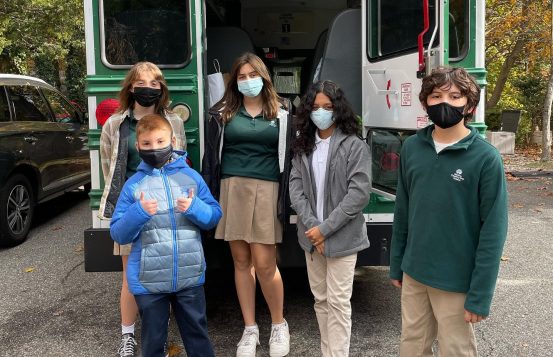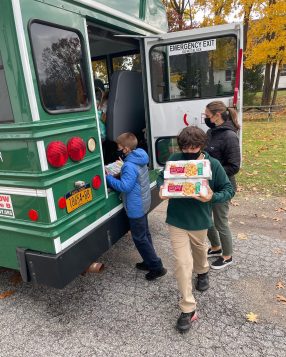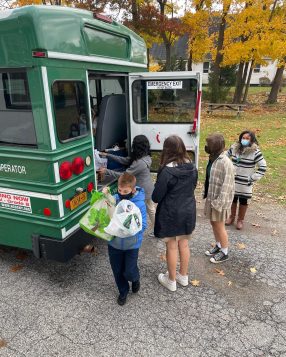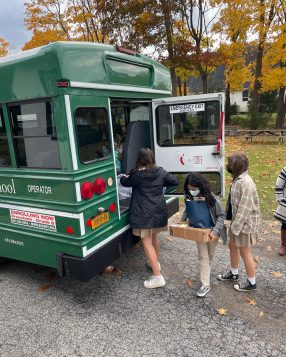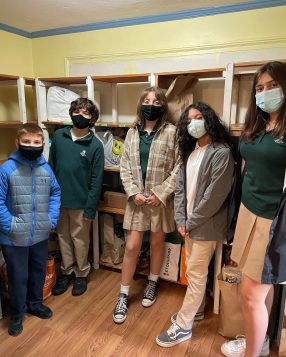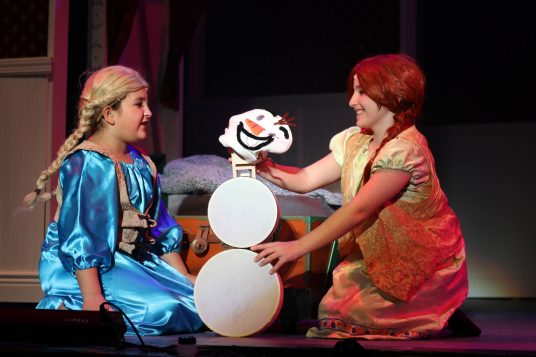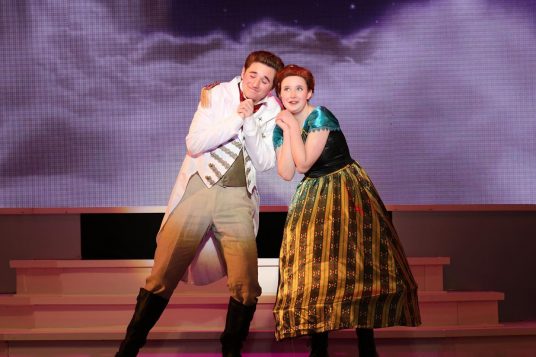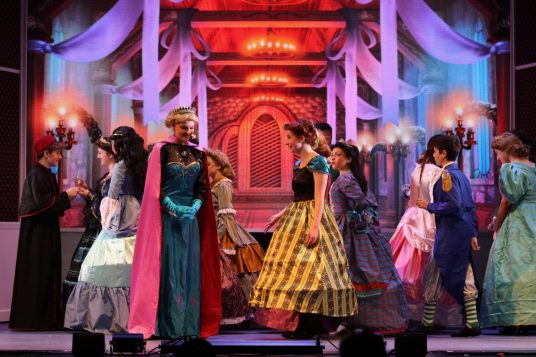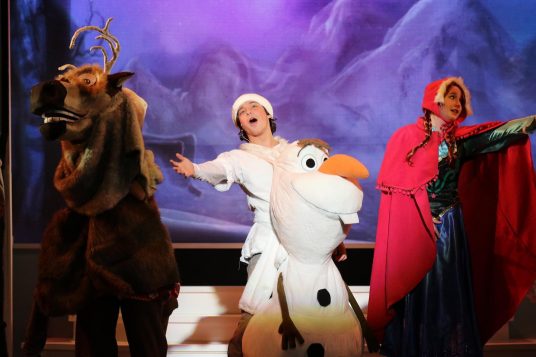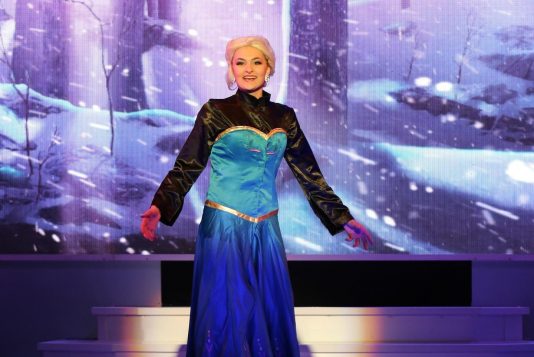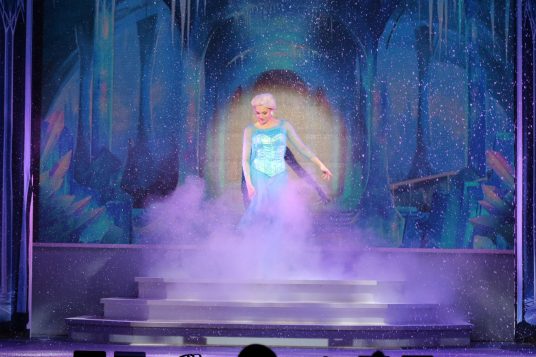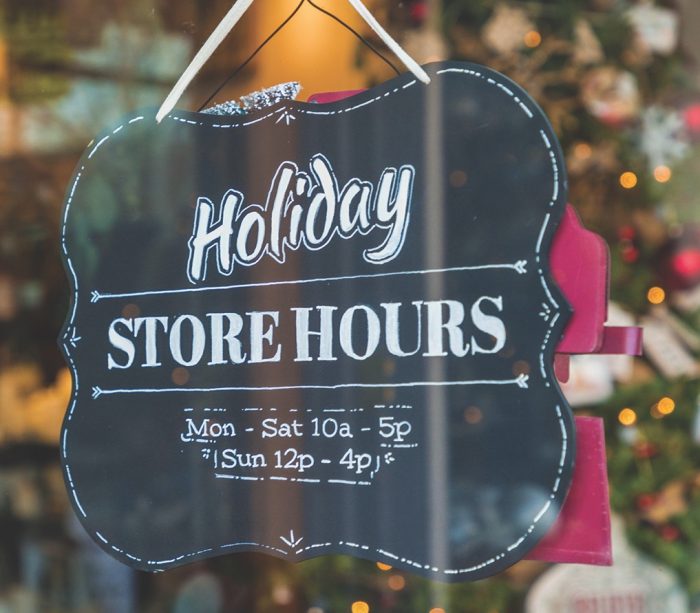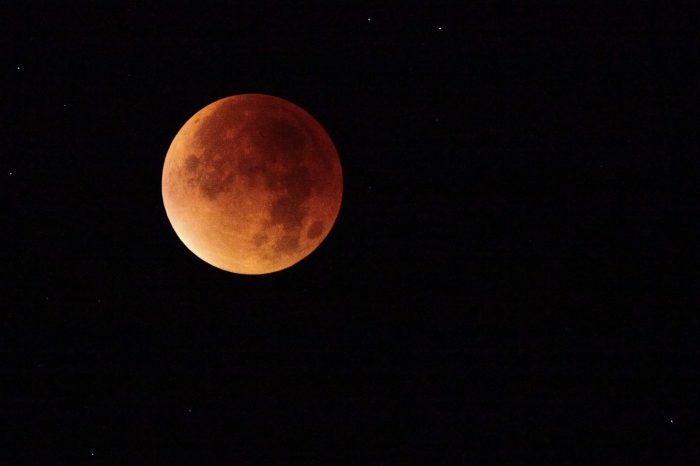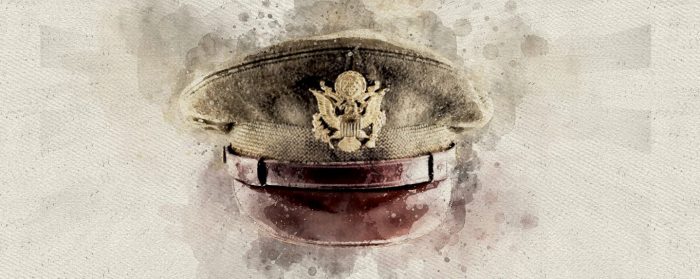Harbor Country Day School students host annual food drive
GIVING BACK
To celebrate the spirit of giving this holiday season, the students of St. James’ Harbor Country Day School’s Student Council conducted their annual food drive to benefit the Smithtown Emergency Food Pantry. Over the course of two weeks, more than 500 pieces of nonperishable food items were collected. On Nov. 15, those donated items were then delivered to the Food Pantry by Student Council officers.
As shared by Pat Westlake, the Director of the Smithtown Emergency Food Pantry, “The Smithtown Food Pantry looks forward to welcoming the students from Harbor Country Day School – as their green bus pulls into our driveway we know it is filled with food that the students have collected. The smiling students have collected the food, sorted, and packed it. They now carry it into the pantry where it will be distributed to our neighbors who suer from food insecurity. The pantry relies solely on donations and Harbor Country Day School greatly helps us to fulll our mission of providing assistance to all who come to us. During October we estimate that we provided over 15,000 meals to our clients and we look forward to continuing our eorts as the holiday season approaches.”
The Smithtown Emergency Food Pantry has been serving Smithtown and the surrounding communities since it was founded in 1984. In 2021, the organization provided Thanksgiving dinner xings for close to 300 local families.
Theater Review: Head to the Smithtown Center for the Performing Arts for a magical ‘Frozen Jr.’
By Heidi Sutton
When Hans Christian Andersen penned “The Snow Queen” in 1844 he surely had no idea that his beautiful fairy tale would live on and serve as the inspiration for Walt Disney Animation Studio’s Frozen over 150 years later. The second highest-grossing animated movie of all time, (Frozen II is the highest) it has morphed into a Broadway musical, short films, Disney on Ice and everything in between.
Now the timeless tale heads to the Smithtown Center for the Performing Arts Center for 29 performances in the form of Frozen Jr. With music and lyrics by Kristen Anderson-Lopez and Robert Lopez and book by Jennifer Lee, the show features all of the beloved songs from the animated film along with a few fun new ones.
The story follows two sisters who are princesses in the kingdom of Arendelle. The eldest, Elsa, was born with magical powers that allow her to create ice and snow. As a young child, Elsa doesn’t know how to control her powers and while building a snowman she accidentally harms her sister Anna. Although Anna is healed by the mysterious Hidden Folk, their parents decide it would be best to protect Anna by keeping the two apart.
Anna, who has no memory of the accident, can’t understand why her sister avoids her. When the parents are lost at sea, Elsa stays in her room, keeping her secret hidden from her sister and the outside world.
Ten years have passed and it is time for Elsa to become Queen, but on coronation day her magic unintentionally brings an eternal winter to the kingdom. Accused of sorcery, she flees into the mountains to hide. Anna enlists the help of Kristoff the icemaker to help her find her sister and free Arendelle from the spell. Will she succeed?
Directed and choreographed by Courtney Braun with musical direction by Melissa Coyle, the production is polished from start to finish. Ranging in age from 8 to 17, the 24-member cast is extremely talented and clearly love what they are doing. Special mention must be made of Leah Kelly and Lorelai Mucciolo for standout performances in the role of Elsa and Anna.
Lorelai’s bubbly personality shines in “Do You Want to Build a Snowman?,” “For the First Time In Forever” and in her fun duet, “Love is An Open Door,” with Luke Hampson who plays the role of Hans. In contrast, Leah’s character is more reserved, fearful of the powers inside her, and carries herself like royalty. Her vocals are incredible and she literally brings the house down with her powerful number “Let It Go.” Both are perfectly cast.
Elena Grassi and Jillian Cerrato as Young Anna and Young Elsa and Riley Ferraro and Gabby Blum as Middle Anna and Middle Elsa set up the relationship between the two sisters perfectly. Much to the delight of the younger children in the audience, Olaf the Snowman (played by Ryan Romanelli) and Sven the reindeer (played by Derek Hough) make an appearance as well.
Costumes, designed by Chakira Doherty, are stunningly beautiful and her attention to detail is impeccable. Of special note is when Elsa changes costumes mid-song during “Let It Go” and turns into an ice queen with a beautiful blue shimmering dress, drawing gasps from the audience.
A nice addition is the animated projections on a screen depicting different locations in the Kingdom of Arendelle including the inside and outside of the castle, the snowy mountains and Elsa’s ice castle. Large panels on either side of the stage turn with the scenes and the lighting pulls it all together for a magical experience.
The Smithtown Center for the Performing Arts has gone all out in this production and it shows. The team has succeeded in bringing the the mystical world of Arendelle to life on the stage. If your child loves Frozen, they will love this show. And what’s better than live theater? Costumes are encouraged and booster seats are available. Meet Elsa and Anna in the lobby for a photo and pick up a Frozen souvenir on your way out.
The cast: Leah Kelly, Lorelai Mucciolo, Brody Hampson, Ryan Romanelli, Derek Hough, Luke Hampson, Ari Spiegel, Michael Gualtieri, Ryan Van Nostrand, Gabrielle Arroyo, Justin Walsh Weiner, Zachary Podair, Alia Romanelli, Elena Grassi, Jillian Cerrato, Gabby Blum, Dori Alghrim, Riley Ferraro, Adrienne Porti, Mairead Camas, Savannah Shaw, Sophia Weiner, Jonathan Setzer and Gianna Oppedisano.
The Smithtown Center for the Performing Arts, 2 E. Main St., Smithtown presents Frozen Jr. through Jan. 17 with a special sensory sensitive performance on Dec. 4 at 7 p.m. All seats are $25. To order, call 631-724-3700 or visit www.smithtownpac.org.
All photos by Courtney Braun
Editorial: Supporting small businesses this holiday season
There are certain things Cyber Monday and the internet can’t do for us as we shop during this holiday season. While the sales may be great online, there are some downfalls that we’ll experience this year making shopping locally even more important.
The next several weeks are going to be hard for devoted holiday shoppers thanks to COVID-19 and the continuous supply chain concerns that are happening across the country.
Experts are anticipating that large retailers like Apple and Amazon will experience a hit with sales due to shipping issues and staffing challenges. And although this will be tough for those businesses, it will also be a stress for the consumers themselves.
Whereas shopping via online Black Friday and Cyber Monday deals in the past was an easy click with shipping coming days after, buyers might see a delay in receiving those products in the mail.
But this might be a good time for us to take a step back and really support our neighbors who own their own shops in our local villages and towns.
Instead of anticipating a package in the mail — which might not even get here on time — we should head into town and shop small this holiday. The goods will be there right in front of us and we can take them home that day — easy one-stop shopping that makes our lives easier, but also provides income to a family owned business.
Shopping small comes with its own benefits: we can see the products, touch them and measure them for size. We can find unique things that may not be available on a larger company website, making that gift a one-of-a-kind present the recipient will treasure.
And on top of that, it provides that shop owner with extra money to pay their own bills. Shopping small is a win-win for everyone.
After a tough two years post the initial outbreak of the pandemic, mom and pops have been hit hard with little ability to recover.
By shopping locally this year, it brings money back to the economy which then goes back to our own street repairs and our community.
We know that online shopping is usually easier, but with the current state of inventory and the surrounding issues, it might actually be better to walk over and visit a family owned shop.
Try it out this holiday season, and you certainly won’t be disappointed.
D. None of the Above: Mundane and magnificent moments during and after a magical moon
By Daniel Dunaief

Ah, the benefits of an older bladder.
Granted, that’s not generally the case. Usually, I get up in the middle of the night, realizing that the dream that involves the search for a bathroom is my brain’s way of telling me that I need to urinate in real life.
I shift my weight slightly toward the floor, hoping that the rocking motion of my body doesn’t move the bed so much that I wake my wife or the cat sleeping on her, who sometimes sees my movement as a starter’s gun to race toward the table in the laundry room to devour another can of the same food he eats every day.
I slide my feet off the bed and try not to step on our huge dog, who moves around often enough that he could easily be that furry thing under my feet. My toes can’t always tell whether that’s him or just the softer part of the inside-out sweatpants I’ve been wearing for a week. I also try to avoid the other cat, whose tail is like a spring waiting for me to step on so he can shriek loudly enough to wake my wife and terrify the other cat and the dog.
When I reach the bathroom, I try to urinate into the bowl but away from the water to avoid any splashing sound. I retrace my steps back to the bed, hoping the safe places to step on the way out from the bed are still safe on the return.
This past week, the bathroom routine gave me the opportunity to look at a rare event. I watched the extended lunar eclipse, which was the longest it’s been in 580 years. I crept out to the hallway to view it through a window, hoping I didn’t have to go out in the cold to catch a glimpse of Earth’s shadow. I was also concerned that the dog, even at 3 a.m., would fear that he was missing out on something and bark, negating my efforts to enjoy the eclipse in silence.
I was amazed at the shadow that slipped slowly across the moon. I took an unimpressive photo that captured the yin and yang of the light and shadow.
The next morning, I ran into some neighbors on my routine walk with my dog.
After saying how they’d stayed up all night to watch this rare event — they are retired and don’t have any time pressure most days — they started to recount their evening.
“I was tempted to dress in black and howl while I watched it,” the man said.
“Excuse me?” I asked.
“Well, you know, I figured as long as I was up, the neighbors on the other side who think it’s OK to play basketball at 11:30 p.m. should know I was awake and active.”
“Hmm,” I said.
“Yeah, and the other day, they had a party and threw beer bottles over the fence into our backyard. It took until late in the day for them to pick them up.”
“That’s terrible,” I said. “Sorry to hear that.”
As I walked back with my dog, who was eager for his post-walk breakfast, I realized we had never discussed the sights from the night before.
Sleep deprivation overshadowed a discussion of the observation of the Earth’s long shadow.
As for me, I was, for the first time, grateful for the momentary need to pee. The evening and the morning interaction that followed brought to the fore a collision of the mundane and the magnificent.
Between You and Me: Chronic migraine reversal with the LIFE diet, a study by a local internist gone viral
By Leah S. Dunaief

A local physician had a remarkable result. In clinical practice, he was treating a patient with severe migraines. The patient, 60 years old, had been experiencing migraines for 12 years. Recently they increased in frequency, and he was enduring six to eight debilitating headaches per month, each lasting more than 72 hours. This equates to 18-24 headache days each month.
For those of us who suffer migraines, we know this must have been horrible. A migraine is not just a bad headache. It is as if a drill were unremittingly penetrating one spot in the head, all the while accompanied by nausea, vomiting and an inability to tolerate light. The aftermath is to feel hung over and unsteady. Migraines steal hours and days from the lives of the afflicted.
The patient had tried various traditional medications, like zolmitriptan and topiramate to no avail. He also avoided possible migraine triggers like aged cheese, caffeine and red wine without success.
The internist, who specializes in lifestyle medicine, put him on a plant-based, high nutrient diet that he created of essentially low inflammatory foods every day. Hence he named it the LIFE diet, and its centerpiece is composed primarily of dark leafy greens, frozen blueberries, a banana and soy milk in a smoothie. These high fiber ingredients, when reinforced with flax seed meal, and a little pomegranate juice, can be made into a 32-ounce drink by a sturdy electric blender. The diet is further reinforced by eating more nutrient-dense veggies, like spinach, kale, arugula and romaine lettuce, for example, at subsequent meals in the day. These foods are thought to reduce chronic inflammation in the body.
The LIFE diet also limits dairy and red meat, whole grains, starchy vegetables and oils, according to reporter Sarah Jacoby, who interviewed the doctor for “Today” last Thursday, Nov. 18.
The results of the new regimen were dramatic. After two months, the patient was experiencing one headache per month. After three months, the headaches were gone. The patient suffered no further migraines. This result has lasted more than seven years so far.
At this point, the local physician, teaming up with his brother, who is a medical researcher, wrote up the study and sent it to the highly prestigious British Medical Journal or BMJ that publishes medical case studies deemed important. Delighted when it was accepted for publication, the doctor, who is a passionate believer in the healing power of dark green leafy vegetables, was further pleased when he learned that BMJ, considering the study valuable enough, had sent out a press release to publications all over the world with a summary.
The response was overwhelming, a testament to the need for a remedy to a universal malady. As of this writing, more than 40 news outlets across the globe, including UPI and WebMD, have picked up the story, from Europe to the Middle East to Asia and Australia, translating it into a dozen different languages.
“I think this (case report) is a tremendous start in the treatment of migraine headaches,” added the local physician. “This is kind of revolutionary to have the ability to say, ‘Not only does it work, but it works in the worst case scenarios. And it works in a short period of time.’” He has seen similar results in other of his patients.
Dr. Charles Flippen, professor of neurology at the David Geffen School of Medicine at UCLA, agreed, stating that the change the patient experienced was, “rather impressive,” especially how long the effect has lasted. He added, “Now a large sample is necessary to draw conclusions about the benefits of diet change on migraines or chronic migraines,” as quoted by Sarah Jacoby for “Today.”
Dr. Dawn Buse, clinical professor in the department of neurology at Albert Einstein College of Medicine in New York said, “There have been some recent studies suggesting that major dietary changes can reduce migraine symptoms,” according to “Today.”
“Even though we don’t know the exact mechanism for migraine, the concept of an inflammatory process as part of the underlying physiology of chronic pain has been around for decades,” explained Flippen. “So the idea that you have a diet that reduces the production of pro-inflammatory substances would fit nicely with our current understanding of migraine … It’s not purely magic that it worked.”
For the doctor, whose work has now circled the globe, the satisfaction is enormous. “I went into medicine to help people. It’s beyond gratifying that I may be helping people to take their lives back by reversing disease with the LIFE diet,” he concluded.
And the name of the local internist who authored the study that has gone viral: my son and our own columnist, David Dunaief, MD.
Elected officials host job fair at SCCC
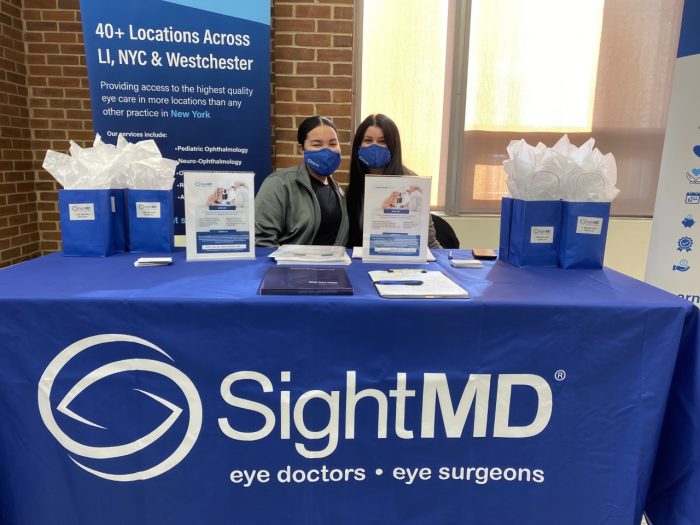
By Sara McGiff
Time to get to work!
On Friday, Nov. 19, state Senator Mario Mattera (R-St. James), New York State Assemblyman Doug Smith (R- Holbrook) and Suffolk County Legislator Nick Caracappa (R-Selden) joined together to host a special Long Island Job Fair at Suffolk County Community College.
From 11 a.m. until 2 p.m. people from across the county visited the Babylon Student Center and spoke with representatives from dozens of different employers face-to-face.
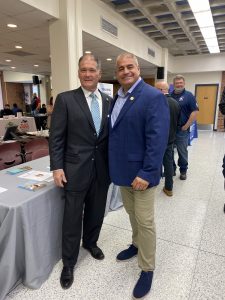
Booths adorned names from all categories of jobs such as the U.S Army, Sportime Tennis Academy, and even Finishing Trades Institute of NY, Painters & Allied Trades. Representatives were able to answer questions to interested visitors, in hopes that it would spark an interest.
The atmosphere was energetic, and the stream of potential employees didn’t cease until the job fair was close to ending.
According to Mattera, the job fair was for those who lost their jobs from the recent government mandates, the COVID-19 pandemic and to help boost the economy.
“Without labor, our economy fails,” he said. “Our goal here is to make sure they, especially the people who lost their jobs, come here and maybe find a new career.”
Caracappa remarked how the turnout for the job fair was outstanding and showed the need from both sides for employment opportunities.
“We made this free,” he said. “We didn’t charge vendors, we’re not charging the community to come here. This is all about opportunity for both sides.”
Town of Smithtown to host special screening of ‘War Stories’ Nov. 21
The Town of Smithtown will premiere its Veterans Documentary, entitled War Stories, on Sunday, November 21 at 6 p.m. at the Smithtown Center for Performing Arts, 2 East Main St., Smithtown. The documentary focuses on local residents who enlisted to serve in the US Armed Forces during war time, from World War II to Present Day.
“I’m forever grateful to the men and women all across the Country who have served in our US Armed Forces. This began as an interview process, so we could document and preserve the stories of patriotism, camaraderie and strength of our brave hometown heroes, for future generations. But it has become so much more. This is our way of saying Thank You for Your Service to our local heroes… for we owe them everything,” said Supervisor Ed Wehrheim.
 Tickets are free and members of the public are encouraged to attend the premiere to show support and gratitude for the Men and Women within our community who served in protection of our Nation’s freedoms. Residents are encouraged to bring non-perishable items for donation, which will be delivered to the United Veterans Beacon House Pantry.
Tickets are free and members of the public are encouraged to attend the premiere to show support and gratitude for the Men and Women within our community who served in protection of our Nation’s freedoms. Residents are encouraged to bring non-perishable items for donation, which will be delivered to the United Veterans Beacon House Pantry.
The Town began production of the Veterans documentary, interviewing service members from World War II, through to modern day conflicts. Filming for the documentary began in 2019 on Veterans Day, November 19th. The film is dedicated in memory of two World War II Veterans; Eddy Reddy and Howard Laderwager, who were filmed for the documentary, but have recently passed away.
For more information, call 631-360-7600.
Traveling on the edge of a pandemic – Part one
Taking a solo backpacking tour through Europe proves the scars of COVID-19 are deep
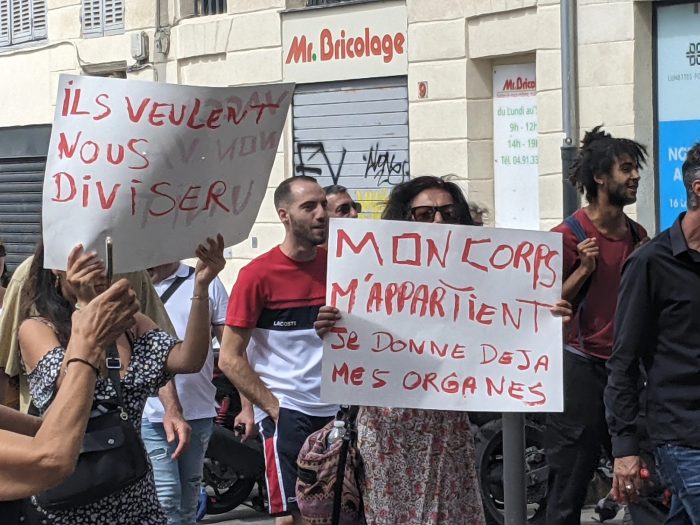
Taking a solo backpacking tour through Europe proves the scars of COVID-19 are deep
By Kyle Barr
France

There was a young man in Toulouse, France, one of only two people in a hostel dorm room, the other being me. We were two in a room meant to facilitate 15. A Parisian traveler, he had taken trains and buses down to Toulouse, named the Pink City (Ville Rose) for its famous blush-red brick. We had a good sight of the street and that colored stone out of the window we shared between our beds.
“I want to see more of my country while I can,” he told me during that cool, wet night in July. He also told me he still hadn’t gotten a vaccine for COVID-19. I had, but I was sleeping just 3 feet away from him.
This should be a normal interaction for travelers through Europe but, in a space like that, the conversation inevitably moves toward the pandemic. He tells me he did not know why he hesitated to get the vaccine. It could have been nerves. It could be the kind of anti-authoritarian impulses that us Americans know only too well. He, along with so many French citizens, have railed against the French President Emmanuel Macron for their mandated proof of a vaccine or negative COVID test for everything from cafés to concerts.
On July 14, Bastille Day, protests rolled out from France’s cities. I watched one in Marseille make its way from the old docks up to the local municipal building. The protesters were shouting “Liberté!” while holding signs reading, “Mon corps m’appartient!” meaning “My body belongs to me!”

But the young Parisian man said that, despite his anger, it could actually change his mind.
“Maybe this will finally make me get the vaccine,” he told me.
Reuters’ data show an estimated 73% of France’s population has been vaccinated. That compares to an approximate 59% in the U.S. I wonder if that young man I met in Toulouse ever got his shot, but we were traveling in opposite directions, and I don’t think I’ll ever know.
There’s only one time that something can be done for the first time. So doing a European backpacking trip is one thing — an enormous thing to do as a novice. Doing it during a once-in-a-century pandemic is another thing entirely.
This past summer I made a very sudden decision to take a two-month backpacking trip through several countries in western Europe, starting June 23 and ending Aug. 18. Beginning in France, I went south to Basque country in Spain, back into France before going into Switzerland, then Germany, the Netherlands, then to Denmark before a quick flight over to Iceland.
My trip began on the very edge of when we all thought the pandemic would subside, just after many European countries started opening their doors to overseas travelers. My trip coincidentally ended just after those same nations started to roll back those open-armed policies. France instituted a COVID passport system just weeks after I left, and it is still only really available to French citizens, meaning that it would be nearly impossible to do half of what I could do just a few months before. Other European countries have instituted new restrictions and lockdowns. It means there was one small three-month period, one golden time slate when the classic Euro tour was still possible. That’s gone now.
Currently, rules are in flux, and Americans may find that restrictions can change between the time they book a trip and their departure dates. Unvaccinated U.S. passengers especially need to keep on top of all the changing regulations.

I wonder now if things will ever return to that golden age of pandemic-era travel and, at the same time, whether we ever should go back. Because even during this perfect period when summer travel was (mostly) possible if one carried a vaccine card tucked inside a passport, adventuring alone in pandemic-scarred lands is not as it once was. It may never be the same again.
Germany
I stayed in a total of 17 hostels, one tiny hotel, two Airbnbs and two stays at kindly people’s homes. During my visit to Hamburg, Germany, I chatted up the hostel staff and heard, like most hostels along my route, they were doing barely 30 to 40% of what they had done in 2019. Backpacking alone relies on one’s ability to strike up conversations with strangers, to meet new people from all over and organize a day’s activities, but the pandemic has done more than hamper worldwide travel. It has also changed certain attitudes. Less people seem to be willing to sit down with strangers to have conversations while the pandemic lingers.
That’s not to say people are more obtuse or less friendly, but there is a sort of wariness hanging about all interactions. Most travelers I met spoke similarly about that general feeling hanging like a cloud above people’s heads. Part of it was the lack of people in hostels, but there also was a defining sense of separation.
Kyle Barr is a freelancer writer and the former editor of The Port Times Record, The Village Beacon Record and The Times of Middle Country.
Smithtown Historical Society hosts community wreath contest
The Smithtown Historical Society (SHS) will host a Community Wreath Contest with a deadline of Dec. 1 at the Roseneath Cottage, 239 E. Main St., Smithtown. Open to all, the wreath must be a minimum of 12″ to a maximum of 24″ in diameter. Any materials may be used. Wreaths will be displayed at the historical society’s Heritage Country Christmas Fair on Dec. 4 (rain date Dec. 5) and the public will select the winners. Entry fee is the donation of your wreath entry to the SHS to use as it sees fit. For more information, call 631-265-6768.



